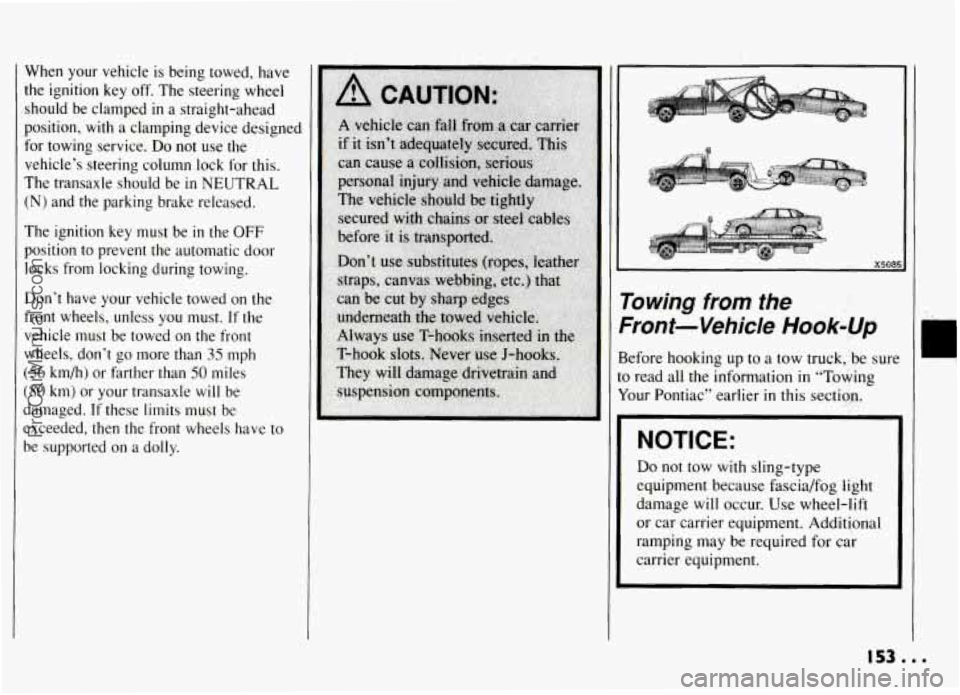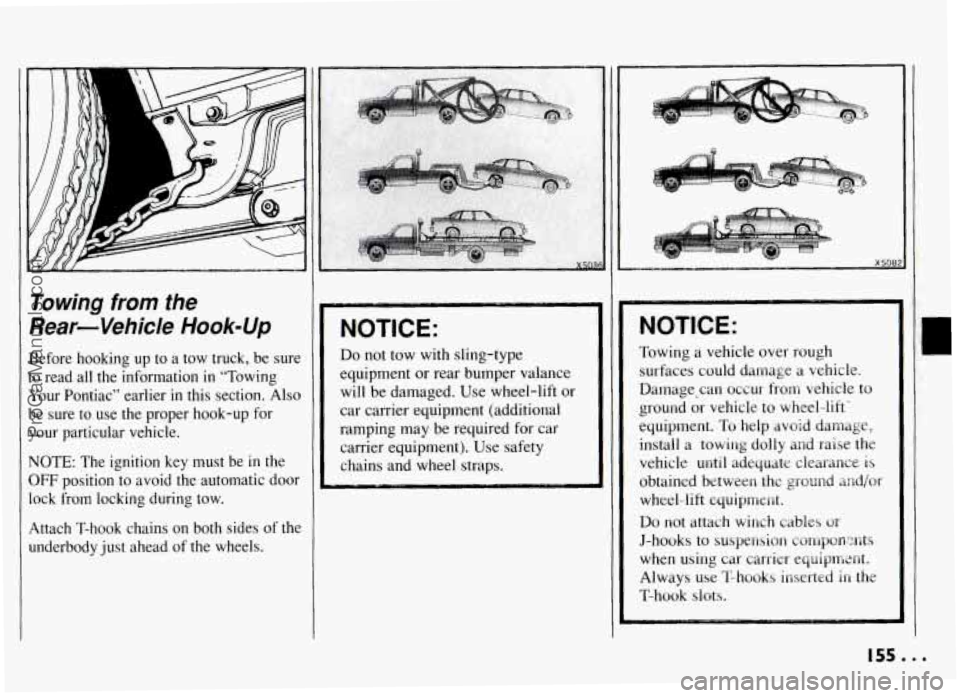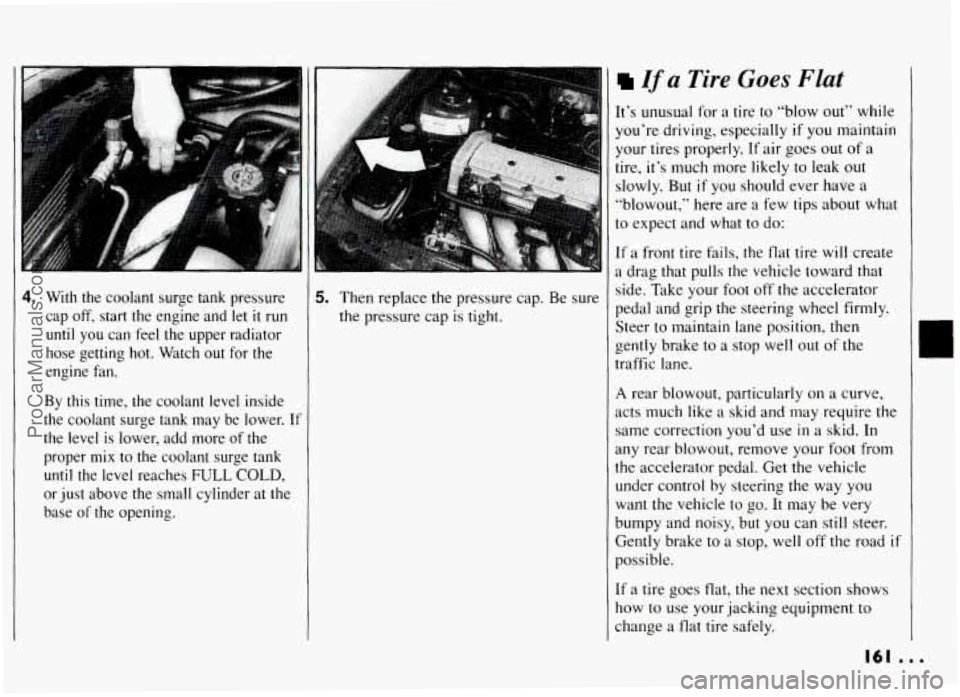Page 154 of 274

When your vehicle is being towed, have
the ignition key off. The steering wheel
should be clamped
in a straight-ahead
position,
with a clamping device designed
for towing service.
Do not use the
vehicle’s steering column lock for this.
The transaxle should be
in NEUTRAL
(N) and the parking brake released.
The ignition key must be in the OFF
position to prevent the automatic door
locks from locking during towing.
Don’t have your vehicle towed on the
front wheels, unless you must. If the
vehicle must be towed on the front
wheels, don’t go more than
35 mph
‘56 i. km/h) or farther than 50 miles
:SO km) or your transaxle will be
ilamaged. If these limits must be
:xceeded, then the front wheels have to
,e supported on a dolly.
,I 7
F
B
tc
Y
I
1
‘owing from the
?ont-Vehicle Hook-Up
efore hooking up to a tow truck, be sur(
1 read all the information in “Towing
our Pontiac” earlier
in this section.
NOTICE:
Do not tow with sling-type
equipment because fascia/fog light
damage will occur. Use wheel-lift
or car carrier equipment. Additional
ramping may be required for car
carrier equipment.
153...
ProCarManuals.com
Page 155 of 274
NOTICE: ~ ~~
Towing a
vehicle over rough
surfaces could damage a vehicle.
Damage can occur from vehicle to
ground or vehicle to wheel-lift
equipment.
To help avoid damage,
install a towing dolly and raise the
vehicle
until adequate clearance is
obtained between the ground and/or
wheel-lift equipment.
Do not attach winch cables or
J-hooks to suspension components
when using car carrier equipment.
Always use T-hooks inserted
in the
T-hook slots.
00. 154
Attach T-hook chains into the slots in the
bottom
of the floor pan, just behind the
front wheels on both sides.
Attach a separate safety chain around the
outboard end of each lower control arm.
ProCarManuals.com
Page 156 of 274

Towing from the
Rear-Vehicle Hook-Up
Before hooking up to a tow truck, be sure
to read all the information
in “Towing
Your Pontiac” earlier
in this section. Also
be sure to use the proper hook-up for
your particular vehicle.
NOTE: The ignition key must be in the
OFF position to avoid the automatic door
lock from locking during tow.
Attach T-hook chains on both sides of the
underbody just ahead of the wheels.
NOTICE:
Do not tow with sling-type
equipment or rear bumper valance
will be damaged. Use wheel-lift or
car carrier equipment (additional
ramping may be required for car
carrier equipment). Use safety chains and wheel straps.
32
NOTICE:
Towing a vehicle over rough
surfaces
could damage a vehicle.
Damage
occur from vehicle to
ground or vehicle to wheel-lift’
equipment.
To help avoid damage,
install a towing dolly and raise the
vehicle
until adequate clearance is
obtained between the ground md/w
wheel-lift equipment.
Do not attach winch cables or
J-hooks to suspension
componxmts
when using car carrier equipment.
Always
use T-hooks inserted in the
T-hook slots.
155...
ProCarManuals.com
Page 162 of 274

7
4. With the coolant surge tank pressure
cap off, start the engine and let
it run
until you can feel the upper radiator
hose getting hot. Watch out for the
engine fan.
By this time, the coolant level inside
the coolant surge tank may be lower. If
the level is lower, add more
of the
proper
mix to the coolant surge tank
until the level reaches FULL COLD,
or just above the small cylinder at the
base
of the opening.
I
5. Then replace the pressure cap. Be sure
the pressure cap is tight.
If a Tire Goes Flat
It’s unusual for a tire to “blow out” while
you’re driving, especially
if you maintain
your tires properly. If air goes out
of a
tire, it’s much more likely to leak out
slowly. But if you should ever have a
“blowout,” here are
a few tips about what
to expect and what to do:
If a front tire fails, the flat tire will create
a drag that pulls the vehicle toward that
side. Take your foot off the accelerator
pedal and grip
the steering wheel firmly.
Steer to maintain lane position, then
gently brake to
a stop well out of the
traffic lane.
A rear blowout, particularly on a curve,
acts much like a skid and may require
the
same correction you’d use in a skid. In
my rear blowout, remove your foot from
the accelerator pedal. Get the vehicle
under control by steering the way you
want the vehicle to go. It may be very
wmpy and noisy, but you can still steer.
Sently brake to a stop, well off the road if
Jossible.
[fa tire goes flat, the next section shows
low to use your jacking equipment to
:hange a
flat tire safely.
161 ...
ProCarManuals.com
Page 163 of 274
Problems on the Road
Changing a Flat Tire
If a tire goes flat, avoid further tire and
wheel damage
by driving slowly to a level
place. Turn on your hazard warning
flashers.
The following steps will tell you how to
use the jack and change a tire.
The equipment you’ll need is in the trunk.
1. Turn the center retainer nut on the
compact spare tire housing
counterclockwise
to remove it, then
lift the tire cover. You
will find the
jacking instruction label on the
underside
of the tire cover.
... 162
ProCarManuals.com
Page 164 of 274
2. Remove the wing bolt securing
the compact spare tire, spacer and
wheel wrench by turning
it
counter-clockwise. Then lift off the
spacer and remove the spare tire.
3. Remove the bolt securing the jack by
turning
it counterclockwise. Then
remove the jack.
4. Remove the band around the jack.
Turn the jack handle clockwise to
raise the jack head a few inches. 5. Using the wheel wrench, remove the
plastic cap nuts (if your vehicle has
them) and loosen all the wheel nuts.
Don’t remove them yet.
On some models, a cover plate must
be removed to find
the wheel nuts.
Carefully use the wedge end of the
wheel wrench to pry
it off.
163...
ProCarManuals.com
Page 165 of 274
Problems on the Road
18 (46cm) 18" (46cm)
Changing a Flat Tire
(CONT.)
i. Near each wheel, there is a notch in
the vehicle's frame. Position the jack
under the vehicle. Raise the jack head
until it fits firmly into the notch
in the
vehicle's frame nearest the flat tire.
Put the compact spare tire near you.
NOTICE:
Raising your vehicle with the jack
improperly positioned
will damage
the vehicle or may allow the vehicle
to fall off the jack. Be sure to
fit the
jack lift head into the proper
location before raising your vehicle.
NOTICE:
Do not jack or lift the vehicle using
the oil pan. The pan could crack and
begin to leak fluid.
7. Raise the vehicle by rotating the
wheel wrench clockwise. Raise the
vehicle far enough
off the ground so
there is enough room for the spare tire
to
fit.
3. Remove all of the wheel nuts, and
carefully pry the wheel cover from the
wheel,
if your flat tire has one. Then
take off the flat tire.
... 164
ProCarManuals.com
Page 166 of 274
9. Remove any rust or dirt from the
wheel bolts, mounting surfaces or
spare wheel.
1O.Place the spare on the wheel mounting
surface.
11,.Replace the wheel nuts with thg
rounded.end of the nuts toward the
wheel. Tighten each nut
by hand until
the wheel
is held against the hub. ‘4 : d-;. .I !I .+ ..$:!7
p ,
165...
ProCarManuals.com